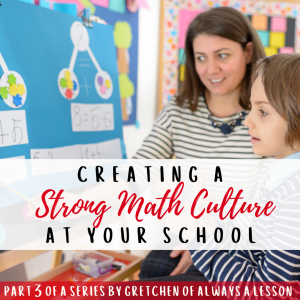Creating a Strong Math Culture at your School [Part Three]
Are your students gaining stronger mathematical skills? Are teachers spending more quality time learning and growing their math instructional knowledge?
 Creating a strong math culture is a topic we have been discussing recently here on the blog based on a discussion I lead on the Clubhouse app. Over 20 educators (classroom teachers, administrators, school board members, instructional coaches, and content area specialists) came together to share ideas and ask questions about how to increase the math culture in their buildings.
Creating a strong math culture is a topic we have been discussing recently here on the blog based on a discussion I lead on the Clubhouse app. Over 20 educators (classroom teachers, administrators, school board members, instructional coaches, and content area specialists) came together to share ideas and ask questions about how to increase the math culture in their buildings.
I am sharing my takeaways here on the blog. This is a three-part post on increasing math culture in your school building. [Click to read post 1 and post 2.]
Today’s question is:
How can we impact math culture as teacher leaders?
Involve Parents
Parents want to participate in their child’s education. They also are curious whether or not their school provides a top notch education, especially in content areas like reading and math.
Create events where parents can see their child’s math work showcased. This gives parents an idea of what goes on in their child’s classroom and they can see how their child is performing.
Teachers can share ideas for how to support mathematical instruction at home in everyday life scenarios (ie. geometric shapes around town, keeping time on a clock throughout the day, etc.).
Parents can get a sense of the math culture in a school just by what is sent home for homework. Is it a scripted curriculum assignment or critical thinking opportunity (ie. solving one difficult problem with many methods accepted versus a worksheet of twenty simple problems to complete with the emphasis on correct answers).
Standards of Mathematical Practice
Create opportunities for teachers to understand the Standards of Mathematical Practice. These are the requirements provided by the state for quality learning in Math. Teachers need to understand what the standards are and how to deconstruct the large skills of the standards and put them into lesson objectives. This is a difficult skill and will require lots of practice and feedback for teachers.
Review state standards with teachers. Place an emphasis on how the standards connect throughout grade levels. Teachers can pull out key terms and discuss various ways to teach the standard, planning for students who get it quickly and those who do not.
Rating Scale
Complete a mathematical proficiency rating scale for every teacher and for the school as a whole. Create the scale from 1 to 10 and assign each number a characteristic that describes confidence and competence of teaching and understanding mathematical concepts for their grade level. This reflective piece encourages transparency and serves as a reality check for the school as a starting point. You can only grow when you know where you are beginning. Honesty is key.
Track Standards
Math is a subject that highly relies on the grade level before it as a foundation for future learning. Most often, there is no way to communicate to the next teacher when students are missing skills or have weak sub skills. Students get even further behind (and even more frustrated). Create tracking sheets and make time for updating and reviewing these sheets periodically to inform instruction. Teachers should track standards taught for each student and mark the proficiency level (not mastered, partially mastered and mastered). This tracking sheet can travel to the next teacher to help inform instruction during the planning phase.
Assist in the Process
There are many moving parts to teaching math. Assist in all aspects (lesson planning process, delivery and execution, designing assessments, reviewing student data, etc.) to catch teacher misunderstanding or negative mindset. Teachers need to know how to plan a thorough lesson that differentiates to a variety of learners. But they also need to plan multiple strategies if students get stuck along the way to present learning in a new way, with multiple opportunities to practice. Knowing what to do when students get hung up helps teachers gain confidence in the content and they can then model perseverance in problem solving to students. Continue to provide support throughout the year as there will be moments of ease and frustration for teachers as they grow their math competency.
If you need leadership resources to help you grow and develop teachers, snag this bundle of coaching forms or watch these quick, actionable “Teachers Who Lead” course modules.
Suggested Resources for Building Math Culture:
- Math Tools & Activities
- Mathematical Mindsets by Jo Boaler
- Elementary and Middle School Mathematics (Teaching Developmentally) by Karen Karp
If you found this helpful, be sure to check out the first and second post in the series.
Go Be Great!
What action will you take to create a stronger math culture in your building?

